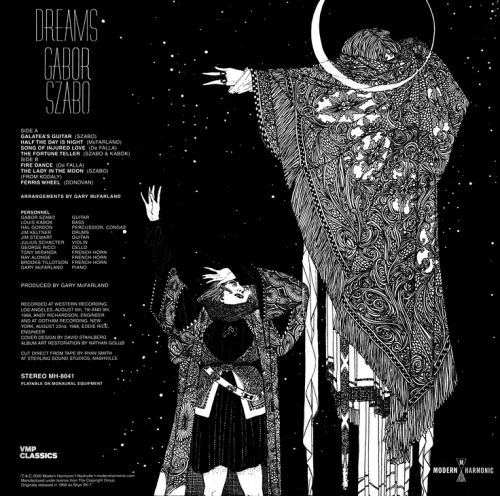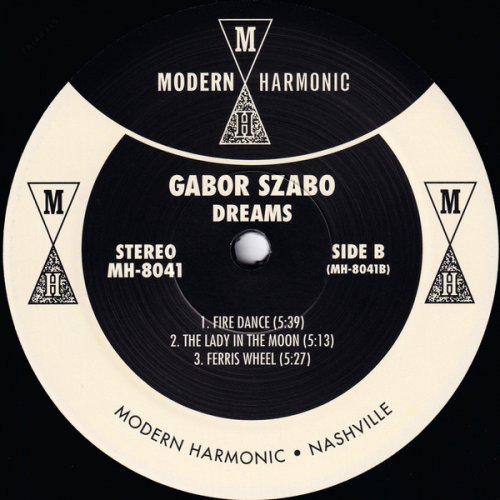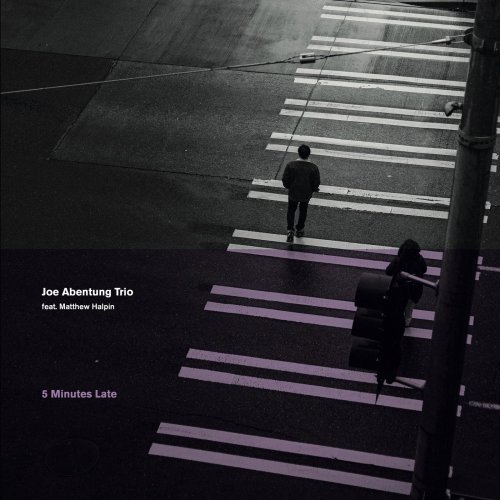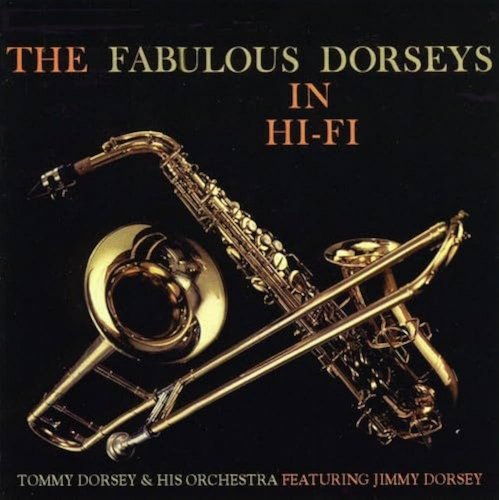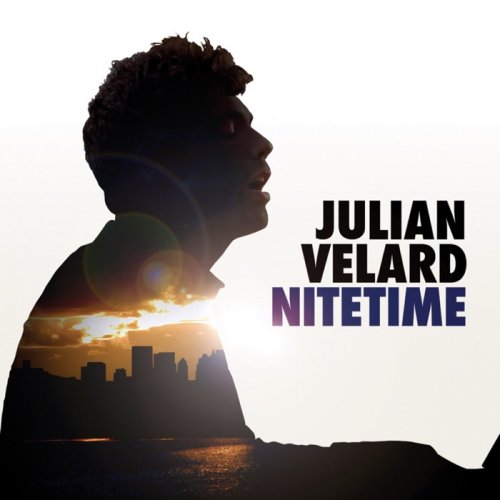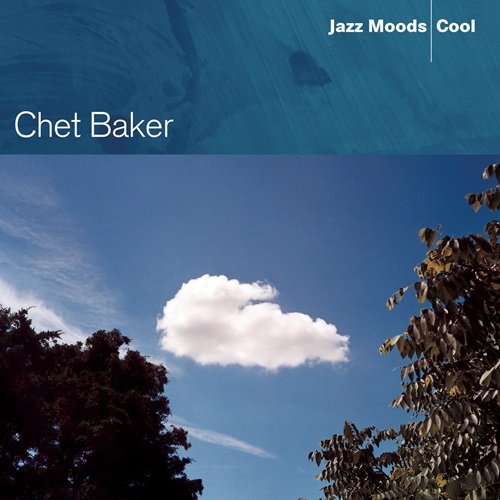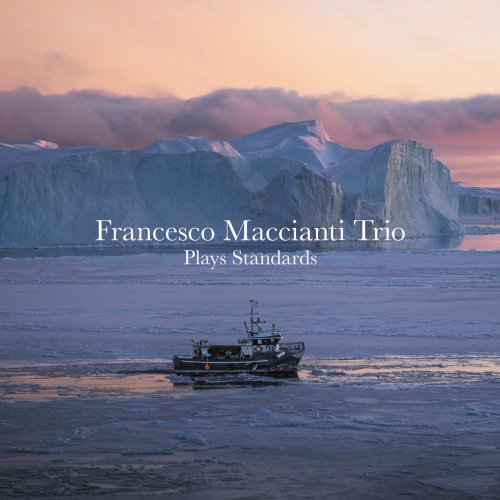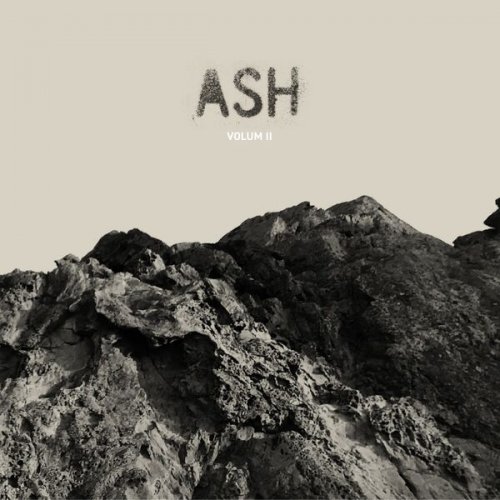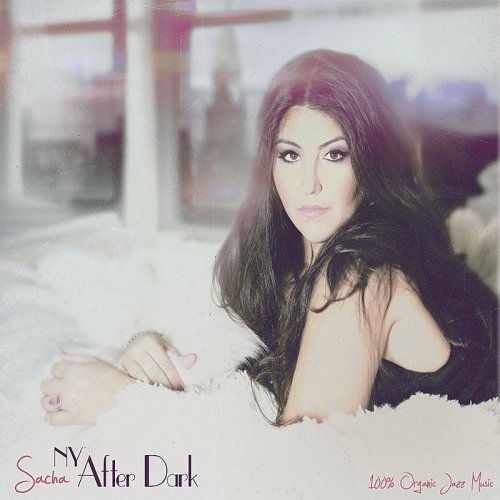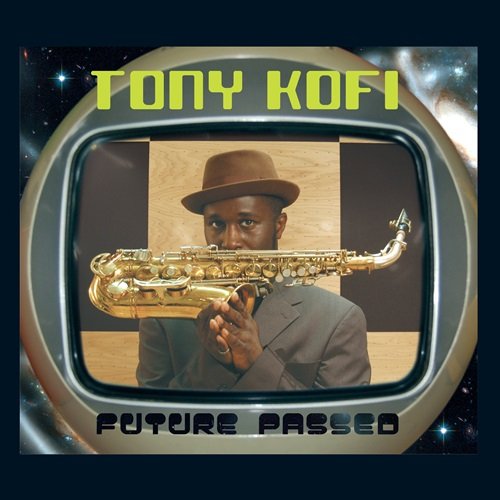Gabor Szabo - Dreams (2020, Limited Edition, Reissue) LP
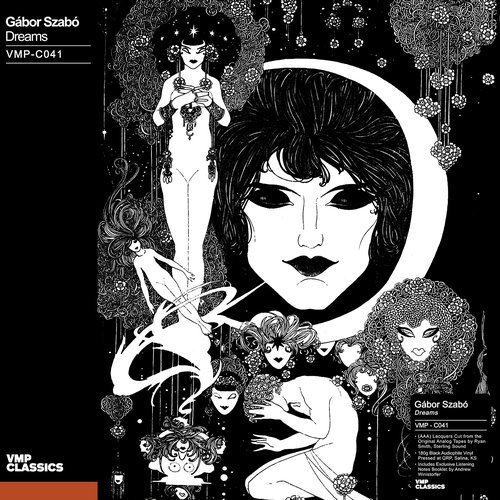
Artist: Gabor Szabo
Title: Dreams
Year Of Release: 2020
Label: Modern Harmonic (MH-8041)
Genre: Crossover Jazz, Third Stream
Quality: FLAC (tracks) 24/192
Total Time: 00:35:54
Total Size: 1.26 GB
WebSite: Album Preview
Tracklist:Title: Dreams
Year Of Release: 2020
Label: Modern Harmonic (MH-8041)
Genre: Crossover Jazz, Third Stream
Quality: FLAC (tracks) 24/192
Total Time: 00:35:54
Total Size: 1.26 GB
WebSite: Album Preview
01. Galatea's Guitar (Szabo) - 5:43
02. Half the Day Is Night (McFarland) - 4:28
03. Song of Injured Love (De Falla) - 4:11
04. The Fortune Teller (Szabo-Kabok) - 4:35
05. Fire Dance (De Falla) - 5:52
06. The Lady in the Moon (Szabo) (From Kodaly) - 5:28
07. Ferris Wheel (Donovan) - 5:37
It’s nearly impossible to write about Gábor Szabó, and his guitar playing, without slipping into something like trying to describe what a ghost looks like to someone who’s unfamiliar with ghosts. You end up using words like “sorcery” and “bewitching” and “haunting” that make his albums sound like a tape of Halloween sounds. This is a guy whose albums had titles like Spellbinder and More Sorcery and Magical Connection; I’m not sure if he personally named his albums, but they acknowledged the spectral quality of what he was getting into. It’s hard, increasingly since his death in 1982 at age 45, to separate the mortal man from the ethereal spirit of his music.
And it’s the hardest to do so in relation to his 1968 masterpiece Dreams, maybe the most accurately titled album in jazz history. Dreams is an album that feels like it emanates from your brainstem, somewhere between ASMR and a tumbling psychotropic fugue state that you never want to leave. It remains as left-field as it was upon release 52 years ago; nothing before or since has captured its blend of Hungarian folk, jazz, pop and chamber music. It was the album Szabó was striving to make as soon as he arrived on the American jazz scene in the late-’50s, when he was a recent émigré from Hungary, getting out from behind the Iron Curtain and onto jazz stages with some of the genre’s greats.
Szabó was born in Budapest in 1936, and came about his jazz education about the only way you could in Hungary then: through Voice of America radio broadcasts, which the U.S. government funded throughout the world after World War II as a form of American propaganda. For more than 40 years, this meant nightly broadcasts of the best jazz America had to offer by the legendary DJ Willis Conover. It was through Voice of America dispatches that stars like Dizzy Gillespie and Dave Brubeck could tour the world as celebrities before mass media existed in its current form.
Szabó became obsessed with the guitar after seeing a Roy Rogers movie and was gifted his own acoustic guitar for his 14th birthday. The guitar was not the well-crafted machine that Szabó heard his heroes play, but he did his best. The cheap instrument — and his one free guitar lesson that came with the guitar’s purchase — led to Szabó developing his distinct and dexterous finger-plucking style; he had to hit his strings harder and in different ways than someone playing a better guitar to get his desired sound, so he became a technically proficient wizard and a stylistic iconoclast. To this day, you can tell a Szabó guitar line when it comes in; he plays like his fingertips each have their own five fingertips, hitting note after note in ways that feel impossible, and phrasing that could only be his.
By the time he was 20, he’d developed into a well-versed, if raw, jazz guitarist, and the pro-communist Hungarian Revolution of 1956 gave him the final push he needed to make it as a professional musician, as he fled Hungary for Austria. Eventually, his whole family would flee the conflict and land in San Bernardino, California. Szabó remembered thinking before moving that jazz would be so plentiful in America that even his milkman there would probably have his own group. But after a couple years trying to eke out a music career and learning American culture, Szabó elected to get formal training at Berklee School of Music in Boston. Like all iconoclasts, he had trouble at school because they tried to force him to play against his own developing style, and due to a lack of funds from the school and elsewhere, he dropped out. He’d leave within two years and head back to California, dejected.
But in 1961, his fortunes changed: He was hired to join drummer Chico Hamilton’s quintet, where he’d play alongside Charles Lloyd, who’d only recently joined the group when Eric Dolphy left. It was under Hamilton’s tutelage that Szabó began to embrace his unique stylings, and began working towards his own unique jazz.
In recordings from this period, you can hear Szabó evolve from a competent background player (1962’s DRUMFUSION was his first album date with the quintet) to someone who could cut a vapor trail through a song with his unique phrasing. Listening to “Conquistadores” from 1965’s El Chico, you can hear Szabó tightrope walk around, through and over the thick percussive groove — part of the locomotion of the song, but entirely above and beside it. He’d also come into his own as an experimentalist spending time in Charles Lloyd’s quartet, alongside bassist Ron Carter and drummer Tony Williams.
It was during his time recording with Hamilton on Impulse! that the label had Szabó start recording albums as a leader himself; his 1966 debut as a leader, Gypsy ’66, laid out the format he’d adapt and perfect. The album blended current pop (it’s first song is a cover of the Beatles’ “Yesterday”), Eastern European folk (the title track), and the smooth jazz he’d been playing under Hamilton. Szabó would record a whopping nine albums at Impulse! as a band leader in 21 months.This output reflected both how comfortable Szabó was getting with the sound he was achieving and his voracious outpouring of material, ranging from covers of standards and pop hits to unique, if searching, originals. His most famous recording from this period is probably 1966’s Spellbinder, as “Gypsy Queen” was covered on Santana’s Abraxas LP, and Santana spent much of his career praising Szabó’s playing. (For a wholesome 18 minutes, search “Carlos Santana talks about Gábor Szabó” on YouTube; he also geeks out about “Conquistadores”).
In 1968, Szabó, along with vibraphonist Cal Tjader and multi-instrumentalist and composer Gary McFarland, started Skye Records, their own indie label imprint. The label’s third LP release was Szabó’s Bacchanal, an album that established the expanding and strengthening of Szabó’s palette, as he was slowly eschewing the more straight-forward jazz of Hamilton; the saccharine covers of Doors songs were gone, and in their place were spacious, free-flowing sonic experiments and compositions, and a smaller, string quartet vibe.
Skye’s seventh LP release is the album that brings us here today, Dreams. Recorded over three dates in Los Angeles, and with overdubs done in NYC two weeks later, Dreams is a one-album spectral religious experience — a version of Inception where the top keeps spinning forever. Szabó is backed up by guitarist Jim Stewart — whose guitar lines serve to ground Szabó’s — bassist Louis Kabok, percussionist Hal Gordon, a trio of French horns, violinist Julius Schacter, cellist George Ricci, labelmate McFarland on piano, and session drummer legend Jim Keltner. The other musicians’ main role serves to create fanciful, rich underpinnings to Szabó, whose guitar lines here rarely repeat, and are virtuosic in their dexterity, technique, and breadth.
Dreams opens with the trickling “Galatea’s Guitar,” a song that keeps unfolding forever like a travel map of the entire universe; its expanses know no bounds. Its namesake, the myth of the statue of a woman built by Pygmalion that came to life, is a good metaphor for Szabó’s jazz: It starts as a fairly stationary thing, but comes to life on the wings of hope and wishes. By the end of the track, it evolves into something resembling funk in its powerful groove and sultry percussion. As it fades, it transitions into the McFarland composition “Half the Day is Night,” a tender ballad that Szabó climbs like a spiral staircase in a Kubrick film.
The center of the album is occupied by a maybe unlikely influence for a jazz album; “Song of Injured Love” and “Fire Dance” are both reimaginings of works by the composer Manuel de Falla, often considered Spain’s greatest 20th century composer. In this period, Szabó’s work was often considered a wave of “third stream music,” which sought to split the difference between free-form jazz and composed classical music, and these two songs are largely why. De Falla’s original compositions played on syncopation and dramatics, which lend themselves well to Szabó reinterpretations. Szabó plucks waves of declarative guitar on top of robust and lush orchestral instrumentation that sounds like it could have been used as court music in the Renaissance.
The album’s lone pop cover is the track that delivers most on Szabó’s goals of blending his disparate influences into his own sound. “Ferris Wheel,” a psychedelic Donovan song from Sunshine Superman, is rendered into a brushed-drum, lilting flower, with call and response between Szabó’s guitar and a trio of French horns. It plays, at points, like a funeral procession by a talented church band, a sabre dance and a song you’d hear at a jazz club, and also features the loosest, freewheeling guitar-playing on the album. It ends Dreams like the best dreams end: in a happy denouement where everything is awesome.
Dreams was released in late 1968. Skye Records was not long for this world; the enterprise would run out of money in 1970, right as the unlikeliest hit of Szabó’s career was beginning to go up the charts. In 1970, Szabó recorded a joint album with Lena Horne (called Lena and Gabor) that saw Horne make a comeback on the charts. Unfortunately, that happened only after Skye went bankrupt, and the hit came to Buddha Records, who had bought the Skye masters and re-released the album, leading to Szabó appearing on national TV during a Horne TV special.
Szabó would spend the ’70s rejoining up with Lloyd (1972’s Waves) and bouncing around various indie label concerns before catching on with Mercury Records for 1976’s Nightflight, an album of lite jazz fusion that established Szabó as a peer with George Benson in the pop jazz space. The 1977 followup, Faces, didn’t do as well, and it would serve as Szabó’s final American album, as he moved back to Hungary in an attempt to kick a heroin addiction that had been on his back for much of the ’70s, and after a messy divorce. Before he left America in 1981, he recorded an album for Atlantic called Femme Fatale that was ultimately rejected by the label, which, inversely to when he left Hungary nearly 25 years earlier, was the final push he needed to pack up his American life and move home. He’d release Femme Fatale later in 1981 on the Hungarian label Pepita.
It would unfortunately be Szabó’s last album, as he’d die in 1982 of unspecified kidney and liver problems. His records would become beloved by record collectors around the world, specifically his Skye Records output, which remains rare and often out of print or bootlegged. His catalog, and style, remain like a heavy fog — something you feel like you can hold, but which you’ll never grasp the edge of.
